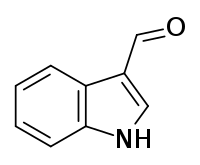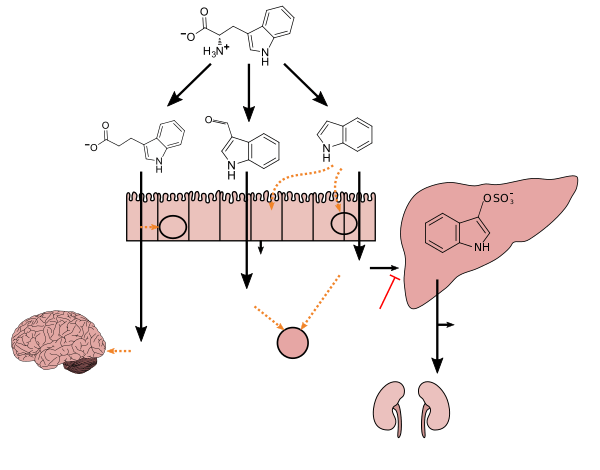Indole-3-carboxaldehyde
Indole-3-carboxaldehyde (I3A), also known as indole-3-aldehyde and 3-formylindole, is a metabolite of dietary L-tryptophan which is synthesized by human gastrointestinal bacteria, particularly species of the Lactobacillus genus.[2][3] I3A is a biologically active metabolite which acts as a receptor agonist at the aryl hydrocarbon receptor in intestinal immune cells, in turn stimulating the production of interleukin-22 which facilitates mucosal reactivity.[2]
 | |
| Names | |
|---|---|
| IUPAC name
1H-Indole-3-carbaldehyde | |
| Other names
3-Formylindole; Indole-3-carbaldehyde; Indole-3-aldehyde | |
| Identifiers | |
CAS Number |
|
3D model (JSmol) |
|
Beilstein Reference |
5-21-08-00246 |
| ChEMBL | |
| ChemSpider | |
| ECHA InfoCard | 100.006.969 |
| EC Number |
|
PubChem CID |
|
| UNII | |
CompTox Dashboard (EPA) |
|
InChI
| |
SMILES
| |
| Properties | |
Chemical formula |
C9H7NO |
| Molar mass | 145.161 g·mol−1 |
| Melting point | 198 °C (388 °F; 471 K) |
| Structure | |
Crystal structure |
Orthorhombic |
Space group |
Pca21 |
Lattice constant |
|
Lattice volume (V) |
710.3 |
Formula units (Z) |
4 |
| Hazards | |
| GHS pictograms |  |
| GHS Signal word | Warning |
GHS hazard statements |
H315, H319, H335 |
GHS precautionary statements |
P261, P264, P271, P280, P302+352, P304+340, P305+351+338, P312, P321, P332+313, P337+313, P362, P403+233, P405, P501 |
Except where otherwise noted, data are given for materials in their standard state (at 25 °C [77 °F], 100 kPa). | |
| Infobox references | |
Biosynthesis in humans and cellular effects
Tryptophan metabolism by human gastrointestinal microbiota ()
|
Chemistry
Antifungal properties
Indole-3-carboxaldehyde has antifungal properties, and partially accounts for the protection from chytridiomycosis seen in amphibian species which carry Janthinobacterium lividum on their skin.[7]
References
- Dileep, C. S; Abdoh, M. M. M; Chakravarthy, M. P; Mohana, K. N; Sridhar, M. A (2012). "1H-Indole-3-carbaldehyde". Acta Crystallographica Section E. 68 (11): o3135. doi:10.1107/S1600536812040573. PMC 3515237.
- Zhang LS, Davies SS (April 2016). "Microbial metabolism of dietary components to bioactive metabolites: opportunities for new therapeutic interventions". Genome Med. 8 (1): 46. doi:10.1186/s13073-016-0296-x. PMC 4840492. PMID 27102537.
Lactobacillus spp. convert tryptophan to indole-3-aldehyde (I3A) through unidentified enzymes [125]. Clostridium sporogenes convert tryptophan to IPA [6], likely via a tryptophan deaminase. ... IPA also potently scavenges hydroxyl radicals
Table 2: Microbial metabolites: their synthesis, mechanisms of action, and effects on health and disease
Figure 1: Molecular mechanisms of action of indole and its metabolites on host physiology and disease - "Indole-3-carboxaldehyde". PubChem Compound. United States National Library of Medicine – National Center for Biotechnology Information. 11 November 2017. Retrieved 17 November 2017.
- Wikoff WR, Anfora AT, Liu J, Schultz PG, Lesley SA, Peters EC, Siuzdak G (March 2009). "Metabolomics analysis reveals large effects of gut microflora on mammalian blood metabolites". Proc. Natl. Acad. Sci. U.S.A. 106 (10): 3698–3703. doi:10.1073/pnas.0812874106. PMC 2656143. PMID 19234110.
Production of IPA was shown to be completely dependent on the presence of gut microflora and could be established by colonization with the bacterium Clostridium sporogenes.
IPA metabolism diagram - "3-Indolepropionic acid". Human Metabolome Database. University of Alberta. Retrieved 12 June 2018.
Indole-3-propionate (IPA), a deamination product of tryptophan formed by symbiotic bacteria in the gastrointestinal tract of mammals and birds. 3-Indolepropionic acid has been shown to prevent oxidative stress and death of primary neurons and neuroblastoma cells exposed to the amyloid beta-protein in the form of amyloid fibrils, one of the most prominent neuropathologic features of Alzheimer's disease. 3-Indolepropionic acid also shows a strong level of neuroprotection in two other paradigms of oxidative stress. (PMID 10419516) ... More recently it has been found that higher indole-3-propionic acid levels in serum/plasma are associated with reduced likelihood of type 2 diabetes and with higher levels of consumption of fiber-rich foods (PMID 28397877)
Origin: • Endogenous • Microbial - Chyan YJ, Poeggeler B, Omar RA, Chain DG, Frangione B, Ghiso J, Pappolla MA (July 1999). "Potent neuroprotective properties against the Alzheimer beta-amyloid by an endogenous melatonin-related indole structure, indole-3-propionic acid". J. Biol. Chem. 274 (31): 21937–21942. doi:10.1074/jbc.274.31.21937. PMID 10419516.
[Indole-3-propionic acid (IPA)] has previously been identified in the plasma and cerebrospinal fluid of humans, but its functions are not known. ... In kinetic competition experiments using free radical-trapping agents, the capacity of IPA to scavenge hydroxyl radicals exceeded that of melatonin, an indoleamine considered to be the most potent naturally occurring scavenger of free radicals. In contrast with other antioxidants, IPA was not converted to reactive intermediates with pro-oxidant activity.
- Brucker, Robert M.; Harris, Reid N.; Schwantes, Christian R.; Gallaher, Thomas N.; Flaherty, Devon C.; Lam, Brianna A.; Minbiole, Kevin P. C. (2008-11-01). "Amphibian chemical defense: antifungal metabolites of the microsymbiont Janthinobacterium lividum on the salamander Plethodon cinereus". Journal of Chemical Ecology. 34 (11): 1422–1429. doi:10.1007/s10886-008-9555-7. ISSN 0098-0331. PMID 18949519.
This article is issued from
Wikipedia.
The text is licensed under Creative
Commons - Attribution - Sharealike.
Additional terms may apply for the media files.
